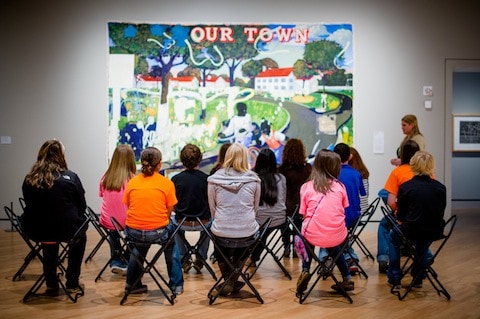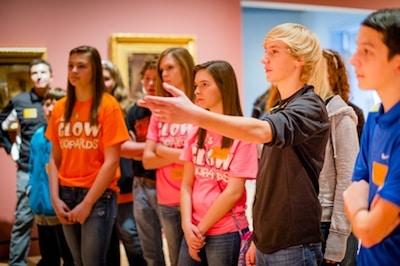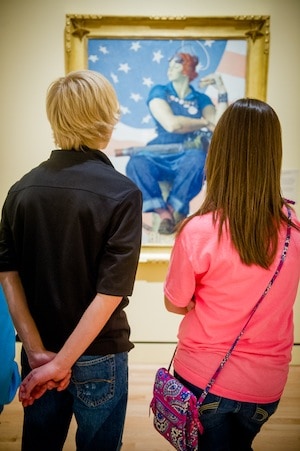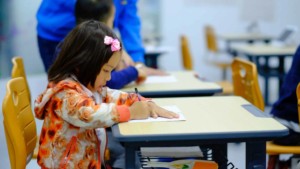Research Reveals Why Students Need Field Trips

By: Anne Kraybill
Recently, the New York Times featured an article in Gray Matter about a random assignment study that measured the effects on students of a one-time field trip to Crystal Bridges Museum of American Art. This random assignment evaluation measured outcomes in more than 11,000 students from throughout the region. The research has gained much attention and sparked discussion among educators and policy makers about the role of cultural enrichment in our students’ learning.
Crystal Bridges was the vision of Alice Walton who believes that everyone should have access to culture. In addition to an endowment program to support the Museum’s operations and acquisitions, Crystal Bridges has also established a $10 million endowment that provides all visiting school groups with 100% reimbursement for the cost of transportation and substitute teachers, as well as a nutritious lunch. The study revealed what the founders of Crystal Bridges have long believed—that learning from works of art promotes knowledge acquisition, critical thinking skills, and skills in the affective domain, including tolerance and historical empathy—with larger gains reaped from minority and rural students. But what is it about the museum experience that might have resulted in student gains in these measures?
 Visiting Crystal Bridges is an awesome experience from the moment the school bus pulls up to the entrance and overlooks the 200,000-square-foot facility on the 120-acre campus. But we believe that it is not just the experience of visiting the Museum that resulted in these student gains. The School Visits Program at Crystal Bridges is a structured experience that is facilitated by a Museum Educator who is on staff, rather than by a volunteer. School tours take place before the Museum is open to the public, a critical element to promoting student-driven discussion in a museum that receives heavy daily visitation.
Visiting Crystal Bridges is an awesome experience from the moment the school bus pulls up to the entrance and overlooks the 200,000-square-foot facility on the 120-acre campus. But we believe that it is not just the experience of visiting the Museum that resulted in these student gains. The School Visits Program at Crystal Bridges is a structured experience that is facilitated by a Museum Educator who is on staff, rather than by a volunteer. School tours take place before the Museum is open to the public, a critical element to promoting student-driven discussion in a museum that receives heavy daily visitation.
Once in the galleries, students visit just four to five works of art during an hour-long tour. A typical stop in front of an artwork asks students to silently look at all aspects of the artwork. After looking, students are invited to contribute an observation, thought, or idea with the group. This invitation allows students to bring their own experiences and ideas to interpreting a work of art alongside a professional who can bring to light contextual information that may be outside the students’ experience and interpretive framework. The process is fluid, and both student and teacher are learners and experts. The learning space becomes one where ideas and knowledge are generated, not simply transmitted, in both cognitive and affective realms.
Crystal Bridges follows a tradition of education in art museums, which have long played a role in igniting curiosity in K-12 student learning. As early as 1907, a concerted effort was underway to connect the Museum of Fine Arts in Boston with colleges and public schools. While the general aim was to e nhance studies, a larger purpose was to “prepare the younger among us for the message of the future by leading them to receive that of the past” with the goal to “awaken or stimulate attention rather than to teach.” Learning from works of art enables students to emotionally connect with history and focus their attention for a sustained amount of time on one piece of information—a huge feat in the age of visual bombardment.
nhance studies, a larger purpose was to “prepare the younger among us for the message of the future by leading them to receive that of the past” with the goal to “awaken or stimulate attention rather than to teach.” Learning from works of art enables students to emotionally connect with history and focus their attention for a sustained amount of time on one piece of information—a huge feat in the age of visual bombardment.
After a tour with high school students from the rural community of Amity, Arkansas, a football player from the group was interviewed to learn a bit about his impressions of the program. The teen—who stood at over 6 feet and 250 pounds within a circle of football buddies—does not reflect the stereotypical image of a young visitor to an art museum. He reflected on the experience and revealed that the painting that resonated the most with him was Our Town, by Kerry James Marshall. When asked why, he said he had never fully comprehended the inequities faced by African Americans until he discussed alternative viewpoints offered by this artist. The act of looking and discussing works of art allows each of us to learn beyond the realm of our own experience.
This study confirms the significance educational programs offered by art museums and cultural institutions have in our students’ educational outcomes. In a time when many districts are scaling back on field trips due to budgetary constraints or to fear that the time spent on a field trip is time lost in “seat time,” this research helps to advocate for learning outside the traditional school setting.
Museums and cultural institutions have the capacity to expand students’ worlds, especially students whose access to enrichment is disadvantaged from that of their wealthier peers. Museums and cultural endeavors are often supported by the generosity of philanthropists who recognize that access to culture is more than access to beautiful things, it is access to the world of ideas, which everyone in the world deserves.
 ANNE KRAYBILL: Distance Learning Project Manager at Crystal Bridges Museum of American Art. With a team of educators, she developed and implemented all of the Museum’s K-12 programming. Prior to joining Crystal Bridges, she worked as the Art School Director at the Durham Art Council, managing visual and performing arts classes for more than 3,000 youth and adult students annually. She is currently developing a distance-learning initiative for Crystal Bridges and pursuing her PhD in Education Policy at the University of Arkansas.
ANNE KRAYBILL: Distance Learning Project Manager at Crystal Bridges Museum of American Art. With a team of educators, she developed and implemented all of the Museum’s K-12 programming. Prior to joining Crystal Bridges, she worked as the Art School Director at the Durham Art Council, managing visual and performing arts classes for more than 3,000 youth and adult students annually. She is currently developing a distance-learning initiative for Crystal Bridges and pursuing her PhD in Education Policy at the University of Arkansas.




0 Comments
Leave a Comment
Your email address will not be published. All fields are required.